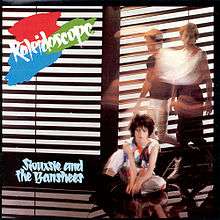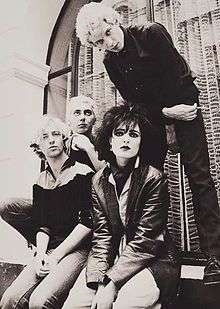Kaleidoscope (Siouxsie and the Banshees album)
| Kaleidoscope | ||||
|---|---|---|---|---|
 | ||||
| Studio album by Siouxsie and the Banshees | ||||
| Released | 1 August 1980 | |||
| Recorded | 1980 | |||
| Genre | Post-punk | |||
| Length | 40:44 | |||
| Label | Polydor | |||
| Producer |
Nigel Gray Siouxsie and the Banshees | |||
| Siouxsie and the Banshees chronology | ||||
| ||||
| Singles from Kaleidoscope | ||||
|
||||
Kaleidoscope is the third studio album by English rock band Siouxsie and the Banshees, released in 1980 by record label Polydor. With the arrival of two new musicians, Budgie on drums and John McGeoch on guitars, the band changed their musical direction and offered an album containing a wide variety of colors. "It was almost a different band", said Siouxsie.[1]
The album was preceded by the hit singles "Happy House" and "Christine". In the UK, Kaleidoscope quickly became their most successful album to date, climbing at N°5 in the albums chart.
Background and music

Following the departure of two band members, the band regrouped and redirected their sound for their third record. Departing from their previous work, the Banshees incorporated synthesizers and drum machines for the first time. They particularly experimented in electronic music on a couple of tracks: the electro-dance minimalism of "Red Light" and the atmospheric, synth-based piece "Lunar Camel". The album also contained what could be described as a ballad, "Desert Kisses". Kaleidoscope marked the debut of guitarist John McGeoch and new drummer Budgie. Siouxsie saw it "like a new lease of life".[2] The songs had been demoed at Warner Chappell studios with only a bass and a synthesizer played by Siouxsie and Steven Severin. After the 1979's tour, Siouxsie had been ordered to take one month of rest by doctors: she used this time to learn guitars and compose music for the first time.
Release and critical reception
| Professional ratings | |
|---|---|
| Review scores | |
| Source | Rating |
| AllMusic | |
| Melody Maker | favourable[4] |
Kaleidoscope was released on 1 August 1980 by record label Polydor. The album peaked at No. 5 in the UK Albums Chart, the highest position the band has achieved to date.[5]
The reception from critics was positive. Paulo Hewitt of Melody Maker's Paulo Hewitt praised the album, and qualified "Paradise Place" and "Skin" as "classic Banshee pieces. Hypnotic, relentless and incisive, both feature Steve Jones on guitar, revealing a hitherto unknown side of the (S)ex-Pistol".[4] Their work on the singles "Happy House" and "Christine" was also hailed shortly after their release by peers The Jam; singer-songwriter Paul Weller said that both songs used "some unusual sounds", while drummer Rick Buckler qualified them as "innovative".[6] [7]
In his retrospective review, David Cleary of AllMusic described Kaleidoscope as a "strong record" with "extraordinarily imaginative production values, featuring intricate synthesizer-flecked arrangements; psychedelic touches in "Christine", spaceship synthesizer swoops in "Tenant" and rhythmic camera clicks in "Red Light" all enliven their respective songs".[3]
Legacy
Kaleidoscope later had an impact on several critically acclaimed musicians. In a 1985 interview with Steve Sutherland, The Cure frontman Robert Smith cited the album when describing The Head on the Door: "It reminds me of the Kaleidoscope album, the idea of having lots of different sounding things, different colours."[8]
In a February 2008 interview on BBC Radio 2, Johnny Marr from The Smiths discussed McGeoch's contribution on "Happy House":
What is it about "Happy House" from a guitar player point of view. For start, it's modern. It's not going in any of these creaky or rock'n'roll aspects to it and it still sounded like the Banshees, or even more so. That's when I really began to become a fan of John McGeoch. It was a extra bonus for me. They had got a great guitar player who had left another band and came in. Not surprisingly, that to me was a very good scenario. I've always liked that. It was like get John's best on the guitar.[9]
Santigold claimed to take inspiration from the song "Red Light", explaining, "'My Superman' is an interpolation of a Siouxsie Sioux song, 'Red Light'. "I love her song and I love this song."[10] Santigold also later sampled another song off Kaleidoscope, "Lunar Camel", on her Top Ranking remix album. Jeremy Jay covered the same song on his Airwalker EP.
Kaleidoscope was also praised by the singer of Suede, Brett Anderson.[11] Erasure's Andy Bell said: "More commercial offering from Siouxsie was much more up my street - and consequently, as with all my favourite teen angst albums, I learnt all of the songs inside out and backwards."[12]
Track listing
All lyrics written by Siouxsie Sioux, except "Red Light" and "Christine", by Steven Severin, all music composed by Sioux and Severin, except "Trophy", by Sioux, Severin and John McGeoch.
| Side A | ||
|---|---|---|
| No. | Title | Length |
| 1. | "Happy House" | 3:52 |
| 2. | "Tenant" | 3:41 |
| 3. | "Trophy" | 3:19 |
| 4. | "Hybrid" | 5:31 |
| 5. | "Clockface" | 1:53 |
| 6. | "Lunar Camel" | 3:02 |
| Side B | ||
|---|---|---|
| No. | Title | Length |
| 7. | "Christine" | 2:59 |
| 8. | "Desert Kisses" | 4:15 |
| 9. | "Red Light" | 3:21 |
| 10. | "Paradise Place" | 4:34 |
| 11. | "Skin" | 3:49 |
| 2006 remastered reissue bonus tracks | ||
|---|---|---|
| No. | Title | Length |
| 12. | "Christine (Warner Chappell Demo Version, February 1980)" | |
| 13. | "Eve White/Eve Black (Warner Chappell Demo Version, February 1980)" | |
| 14. | "Arabia (Lunar Camel) (Warner Chappell Demo Version, February 1980)" | |
| 15. | "Sitting Room (Unreleased Track, Warner Chappell Demo, February 1980)" | |
| 16. | "Paradise Place (Polydor Demo Version, March 1980)" | |
| 17. | "Desert Kisses (Polydor Demo Version, March 1980)" | |
| 18. | "Hybrid (Polydor Demo Version, March 1980)" | |
| 19. | "Happy House (Polydor Demo Version, March 1980)" | |
| 20. | "Israel (7" A-Side)" | |
Personnel
- Siouxsie and the Banshees
- Siouxsie Sioux – vocals, acoustic and electric guitar, finger cymbals, camera, melodica, production
- Steven Severin – bass guitar, electric guitar, vocals, piano, synthesizer, electric sitar, production
- Budgie – drums, harmonica, bass guitar, percussion, production
- John McGeoch – guitar, saxophone, Farfisa organ, sitar, string synth, production
- Additional personnel
- Steve Jones – lead guitar on "Clockface", "Paradise Place" and "Skin"
- Technical
- Nigel Gray – production
References
- ↑ Goddard, Simon. Mozipedia: The Encyclopaedia of Morrissey and the Smiths [Sioux, Siouxsie entry]. Ebury Press. p. 393.
- ↑ "The Banshees and other Creatures". BBC2 television. 1 hour documentary. Broadcast September 1998
- 1 2 Cleary, David. "Kaleidoscope – Siouxsie and the Banshees". AllMusic. AllRovi. Retrieved 2 September 2012.
- 1 2 Hewitt, Paulo (26 July 1980). "Siouxsie's Sketches". Melody Maker. Retrieved 2 September 2012. (subscription required)
- ↑ "Siouxsie & the Banshees [uk charts]". officialcharts.com. Retrieved 29 April 2013.
- ↑ "Desert Islands Disc: The Jam List Their Current Favourite Records". Flexipop (1). 1980. Retrieved 6 December 2014.
- ↑ "Desert Islands Disc: The Jam List Their Current Favourite Records". Flexipop (1). 1980. Retrieved 6 December 2014.
- ↑ Sutherland, Steve (17 August 1985). "A Suitable Case for Treatment". Melody Maker.
- ↑ "Spellbound: The Story of John McGeoch (4/6)". YouTube. 7 January 2010. Retrieved 6 December 2014.
- ↑ Hresko, Lisa (28 April 2008). "All That Glitters Is Santogold". CMJ. Retrieved 2 September 2012.
- ↑ "Some Current Fascinations". brettanderson.co.uk. Retrieved 1 November 2011.
- ↑ "Erasure's Andy Bell Selects 13 Favourite Records". quietus.com. 26 April 2011. Retrieved 5 March 2015.
| ||||||||||||||||||||||||||||||||||